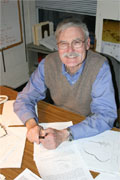An overview of the Chandra mission and goals, Chandra's namesake, top 10 facts.
Classroom activities, printable materials, interactive games & more.
Overview of X-ray Astronomy and X-ray sources: black holes to galaxy clusters.
All Chandra images released to the public listed by date & by category
Current Chandra press releases, status reports, interviews & biographies.
A collection of multimedia, illustrations & animations, a glossary, FAQ & more.
A collection of illustrations, animations and video.
Chandra discoveries in an audio/video format.
Disclaimer: This material is being kept online for historical purposes. Though accurate at the time of publication, it is no longer being updated. The page may contain broken links or outdated information, and parts may not function in current web browsers. Visit chandra.si.edu for current information.
User Support Expert Steps Down
March 3, 2005 ::
Every year about this time scientists who want to use Chandra to make an observation are frantically putting the finishing touches on proposals which will go to the Chandra Director's Office (CDO). There, the hard-working CDO staff will sort the proposals into categories and distribute them to panels of independent scientific reviewers as part of a lengthy peer review process.
The framework for the crucial peer review process was established by Fred Seward in 1993, long before there were any users, and long before there was a Chandra X-ray Observatory. The observatory, which was called
AXAF while it was being built, would not be finished and
launched until 1999. By the time he resigned in 2004, Seward had supervised the review of some 4,000 proposals for Chandra time, and recommended about 1,000 observing proposals.
Seward was the natural and highly popular choice for the position of user support group leader when the AXAF Science Center (which was later renamed the Chandra X-ray Center) was established at the Smithsonian Astrophysical Observatory. He was highly regarded for his pioneering contributions to X-ray astronomy, and widely recognized as uniquely qualified in the practical, sometimes esoteric art of helping the scientific community use an X-ray observatory. From 1977 through 1981 he had organized and led the Einstein Observatory Guest Observer program.
The
Einstein program helped bring about a sociological change in
X-ray astronomy. A substantial amount of observing time was reserved for guest observers, thus making X-ray data available to a broad segment of the astronomical community for the first time. This helped propagate the notion that astronomy is best done by looking at the Universe over a wide range of wavelengths, and helped pave the way for the acceptance of the AXAF mission by NASA and the scientific community.
"The tremendous success of the Einstein Guest Observer program is testimony to Fred's leadership and commitment," said Harvey Tananbaum, Director of the Chandra X-ray Center. "Even more indicative of his effectiveness in this role over the years is the emphasis now placed on 'support to the community' at the Chandra X-ray Center. Fred's leadership has trained us all and has made it automatic for CXC staff to 'think of the observers' and how to assist them in their use of Chandra to maximize the science return from the mission."
That hasn't always been easy, largely because of the tremendous demand to use Chandra.
"With Einstein, we had half a dozen reviews," Seward recalled. "With 50-70 proposals, and one committee, I would read them all, and could remember them all. With Chandra there are typically 800 proposals. There is no time to review them all. The number of proposals was a surprise, as was the difficulty in dealing with so many proposals."
Because of this heavy case load, help from the astronomical community has been important and Seward praised the willingness of astronomers to volunteer their time. "It takes so much of their time and effort, but they are essential. It's especially hard to find panel chairs, who are the backbone of the review. Every year, someone couldn't make it, but we could always find someone to take their place."
The key to the success of the program, and the highlight of his tenure, Seward said, "Has been the high quality of the user support staff. Belinda Wilkes (now the leader of user support operations and Assistant Director of the CXC), Andrea Prestwich, Nancy Evans, Paul Green and Diane Hall (of the Data Systems group) are all very competent and great to work with. We couldn't have done it without them."
What's next for Seward?
"I want to finish the analysis of the data on Crab Nebula's X-ray halo, and three supernova remnants in the Large Magellanic Cloud. I also hope to update the book (his book with Phil Charles, Exploring the Universe, published by Cambridge U. Press in 1995)."
And yes, he does intend to submit Chandra observing proposals to the CXC.
Related Chronicle Article:
Choosing Chandra Targets
Related Chronicle Article:
Getting Down To Business - User Support
Disclaimer: This material is being kept online for historical purposes. Though accurate at the time of publication, it is no longer being updated. The page may contain broken links or outdated information, and parts may not function in current web browsers. Visit chandra.si.edu for current information.










